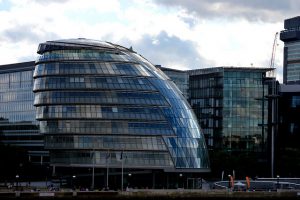Iconic Glass Structures – City Hall, London
City Hall sits on the south bank of the River Thames and was planned and constructed between 1998 and 2002. The building was designed by architect Norman Foster, who was heavily influenced by Frank Lloyd Wright, Bauhaus architect Ludwig Mies Van Der Rohe and Swiss-French architect Le Corbusier. Foster, who initially studied at the University of Manchester, completed his graduate work at Yale University. For a period of time, Foster also collaborated with Buckminster Fuller, the futuristic architect and designer of the geodesic dome. Like Fuller, Foster often worked to design novel housing models for low-income and urban dwellers. Foster was also known for his industrial and commercial building designs.
Construction on City Hall was completed at a cost of about $54 million. The building was constructed on land that had been used for wharves. GLA occupies the building on a long-term lease. It features an unusual bulbous shape that is designed to reduce energy consumption. Although the design employs a double glass façade, tests have shown that the building is not particularly energy efficient.
The building has a generally round shape at the base, meaning that it has no designated front or back side. The interior includes a helical walkway that ascends from the base to the top of the building. The swirling walkway is reminiscent of two other Norman Foster creations, the reconstructed Reichstag Dome in Berlin and 30 St. Mary Axe in London. The open design of the building is meant to convey the transparency and accessibility that modern democratic processes require.
The building contains 10 stories, and provides nearly 20,000 square meters of office and meeting space. The building includes an open-air viewing deck that is sometimes available to the public. Although the claims of the building’s energy efficient design have been questioned, City Hall uses only about one-quarter of the energy of a typical, similarly sized building in London.
Glassprimer™ glass paint is a specialized glass coating that bonds permanently to glass surfaces. GlassPrimer also makes a glass surface molecular activator that is designed to work with UV-inkjet glass printing processes. Glassprimer™ glass paint can be used in both interior and exterior applications and can help reduce solar heat gain in some applications. For more information about Glassprimer™ glass paint, please visit the rest of our site. If you’d like to purchase Glassprimer™ glass paint, please visit our online store .
Photo Credit: Bill Smith, via Flickr.com



